Home
What's New
About Me
Rangefinders
Prismat
Fixed Lens
TL & DTL
XTL & X-1000
MSX & DSX
NC-1000
Z-Series
Other Mamiya
Manuals
Related Links
Camera Prices
Lens Prices
Rest of
Collection
FAQ
Survey
Mamiya 35mm
Forum
How To
Your donations
help to fund this site.
Thanks for your
continued support!
|
|
My Kodak Cameras
Most of my collection is devoted to Mamiya 35mm
cameras, although I do have a modest collection of other cameras,
from a beautiful old (still functional) Burke & James 8x10 View
Camera to early Kodak folders, box cameras and SLR. The Kodak cameras
on this page are all currently in my collection. However, one camera
in the collection, a Kodak Retina IIa, is not currently listed!
Please note, although I have quite a few Kodak cameras, it
is not my typical collecting field, so please don't send inquiries.
My personal knowledge of Kodak equipment is limited. For more information,
try this link.
|
|
Kodak 35
The Kodak 35 (right, c.1938-48)
was the first Kodak 35mm camera produced in the United States. It
produced 24x36mm exposures on 35mm cartridge film.
Typically, it had a 50mm Anistigmat lens and a multi-speed Kodex
No.1 shutter (with 1/25, 1/50, 1/100, plus B and T settings) and
four f-stops from f/5.6 to f/16. It used a pop-up finder to help
frame the pictures.
The back and bottom of the Kodak 35 were made in one piece that
had to be removed to insert film. Film advance and film rewind were
accomplished by the large, knurled plastic knobs on either side
of the top plate.
Different lens/shutter combinations are known to have existed. Some
models (later in the series) had chrome knobs and finder, as well
as a mostly-chrome 51mm lens in a Kodak Diomatic shutter, with f-stops
to f/4.5 and an additional 1/150 shutter speed setting.
There was also a military version produced with an olive drab body.
Much harder to find today, it typically brings from five-to-eight
times more in auction than the common, and relatively inexpensive,
regular models.
|
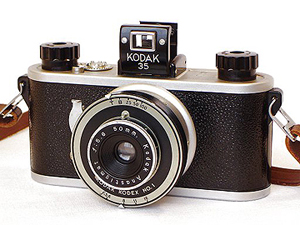
Early Kodak 35 (c.1938) R. Herron Collection
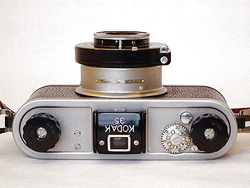 |

|
Kodak Vigilant Junior Six-16
The Kodak Vigilant Junior Six-16
was a folding rollfilm camera produced from 1940-49. It had a folding
frame finder incorporated into its top housing, and another optical
finder near the shutter. It had a single speed lens (approximately
1/100 sec, plus B- and T-settings) in a DAK shutter with f-stops from
f/12.5, f/16, f/22 and f/32. It produced 2-1/2 x 4-1/4 images on 616
rollfilm. |
Kodak Vigilant Six-20
The Kodak Vigilant Six-20 (right,
c.1939-49) was another folding rollfilm camera similar to the Kodak
Vigilant Junior Six-16. However, the Vigilant Six-20 also had a
folding frame finder incorporated into its top housing, and another
optical finder near the shutter.
Lenses available were the Kodak Anistigmat in f/6.3 and f/8.8 variations,
as well as a Kodak Anistigmat Special f/4.5. It produced 2-1/4 x
3-1/4 images on 620 rollfilm.
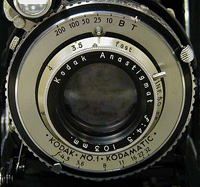
|

|
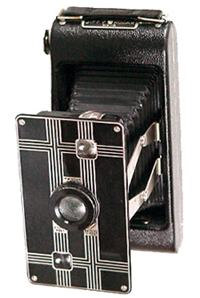
|
Jiffy Kodak Six-20
The Jiffy Kodak Six-20 camera
(left, c.1933-37) was part of a series of inexpensive and popular
Kodak rollfilm cameras, with a pop-out front and twin spring struts.
The Jiffy Six-20 had distinctive art deco front plate (a trait shared
with its "sister" camera, the Jiffy Kodak Six-16). It captured
2-1/4 x 3-1/4 images on 620 film (the Six-16 used 616 film for images
2-1/2 x 4-1/4) |
Kodak Tourist
The Kodak Tourist camera (c.1948-51)
is another of the many folding cameras Kodak produced that provide
2-1/4 x 3-1/4 images on 620 rollfilm. This one came with a 105mm
Kodak Anastar f/6.3 lens in a Kodak Flash Diomatic shutter. It was
also available with Kodak Anaston f/4.5, f/8.8 or Kodet f/12.5 lenses.

|

|

|
Kodak Folding Hawkeye Six-20 Model C
The Hawkeye camera line originated
with the Blair Camera Company, and the name was continued by Kodak
after they absorbed the original Blair company.
The Kodak Folding Hawkeye Six-20 Model C camera (c.1939)
was one of many folding, bellows cameras produced by Kodak. Like
a great many of these Kodak folders, they used medium-format rollfilm
available in the 620 film size. It had a simple lens, with settings
for only "time" and "instant" (roughly 1/100
sec), and used a bright optical finder to locate and compose images.
A similar version known as the Hawkeye Pliant Six-20 Model C was
manufactured in Rochester, NY for the French market..

|
Kodak
Bantam Special
Considered a masterpiece of art-deco
styling, the Kodak Bantam Special used 828 rollfilm for 28x40
exposures. It had an f/2 Kodak Anastigmat Ektar lens and, over the
course of its production, it used two different shutters. From 1936-40
it was made with the Compur Rapid shutter. From 1941-48 it used the
Supermatic shutter. Surprisingly, the Compur Rapid shutter version
is more common today. If you find one with the original box, hang
on to it! Having the original box can increase its auction sale by
up to 50%! |
 |
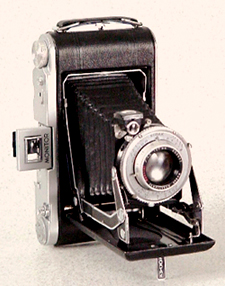
|
Kodak Monitor
The Kodak Monitor cameras (c.1939-48),
like a great many of the early Kodak folders, were folding rollfilm
cameras that were available in the two predominant rollfim sizes,
which were for either 616 or 620 film. They had folding optical
finders and a 127mm lens, in either a Kodamatic or Supermatic shutter
(1/10 - 1/400). The Monitor Six-20 (pictured here, left) is the
more common of the two.
|

|
Kodak Junior Six-16
The Kodak Junior Six-16 (c.1935-37)
was another of the many Kodak folding rollfilm cameras. It had a
folding frame finder incorporated into its top housing, and another
optical finder near the shutter. With a self-erecting bed with a
quick release bar at the front of the bed, and took 2-1/2 x 4-1/4
images on 616 rollfilm.
 |
Kodak Junior Six-16, Series II
The Kodak Junior Six-16, Series II
(c.1937-40) was yet another of the many Kodak folding rollfilm
cameras. It had a folding frame finder incorporated into its top housing,
and another optical finder near the shutter. It had a self-erecting
bed with a quick release bar at the front of the bed, and produced
2-1/2 x 4-1/4 images on 616 rollfilm.
It can be identified by the
octagonal design of the shutter face. There was a similar camera produced
at the same time, called the Kodak Junior Six-20, Series II, which
used 620 film. |
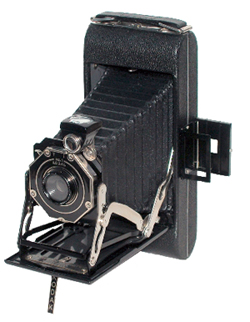
|
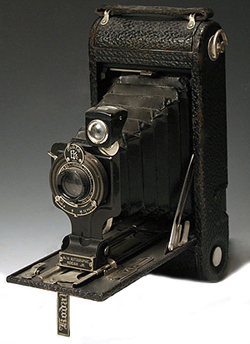
|
Kodak No.1A Autographic
The Kodak No.1A Autographic (c.1914-24)
showcased the autographic feature that was introduced in 1914, and
made available on several camera lines. Covered in black leather and
with a black bellows, it had a small metal stylus, which could be
stored on the camera body. It was used via a small window that opened
onto the back of the film paper as it traversed through the camera.
By opening the small window and applying pressure with the stylus,
you could compress the emulsion on the film, and so record a text
image of your choice, naming each particular frame. The No.1A made
2-1/4x4-1/4 exposures on No. A116 film.
 |
Kodak
Folding Brownie No. 2
The Kodak Folding Brownie No. 2
(c.1904-07) was part of a series of Kodak rollfilm box cameras with
expandable bellows. They are all readily identifiable by their square-cornered
bodies and horizontal format.
The No.2 had a distinctive maroon bellows and a wooden lens standard.
It had an optical finder on the left-hand side of the bed, near the
shutter. With a self-erecting bed with a quick release bar at the
front of the bed, and took 2-1/4 x 3-1/4 images on 120 rollfilm.
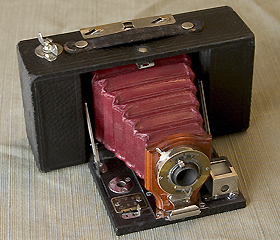
|

|
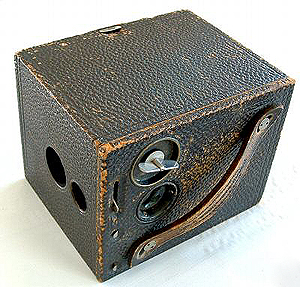
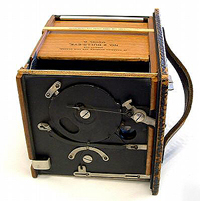
|
Kodak No.2 Bulls-Eye Box Camera
The Kodak No.2 Bulls-Eye, Model
D (c.1897) is the oldest camera in my collection, at 108-years-old.
The Bulls-Eye camera was originally produced by the Boston Camera
Manufacturing Company. After Kodak took over Boston Camera, it continued
Boston's line of cameras under the Kodak name from 1896-1913. Bulls-Eye
cameras are often stamped (as mine is) with the year of manufacture.
A leather-covered wooden box, it loads from the top via a removable
section, and produces 3-1/2 x 3-1/2 images on 101 rollfilm (or double
plateholders). Using rotating-disk aperture stops to provide three
unmarked aperture settings, it has a rotary disk shutter with only
two speeds: bulb (exposing for as long as the shutter release is held),
or instant, which seems to be approximately 1/60 sec in duration.
As you can see in the images at left, the leather exterior conceals
a beautifully polished wooden interior.
 |
Kodak
Brownie Hawkeye Flash
The Kodak Brownie Hawkeye Flash
(c.1950-61) was a molded plastic box camera for 2-1/4 x 2-1/4 exposures
on 620 film with a synchronized flash. An earlier version (c.1949-51),
without the flash, while not rare by any means, is much less common.
A black bakelite box camera identical to the Brownie Hawkeye Flash
was made in France for the French market only. The nameplate on that
version read "Brownie Flash Camera Made in France" and made
no reference to the "Hawkeye" brand name. |
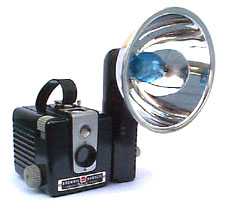 |
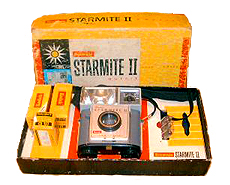
|
Kodak Brownie Starmite II
The Kodak Brownie Starmite (c.1960-63)
and Starmite II (c.1962-67) were inexpensive plastic-bodied
cameras that used 127 film. Film was loaded through the bottom of
the camera, and the Starmite had to be wound after each shot to
reset the shutter. It had a simple viewfinder, a single shutter
speed and a simple lens set at infinity. It used AG-1 flashbulbs.

|
| |
Click here to return to my
Russian camera page, or my
German camera page.
© R.L. Herron
All Rights Reserved. Legal
|